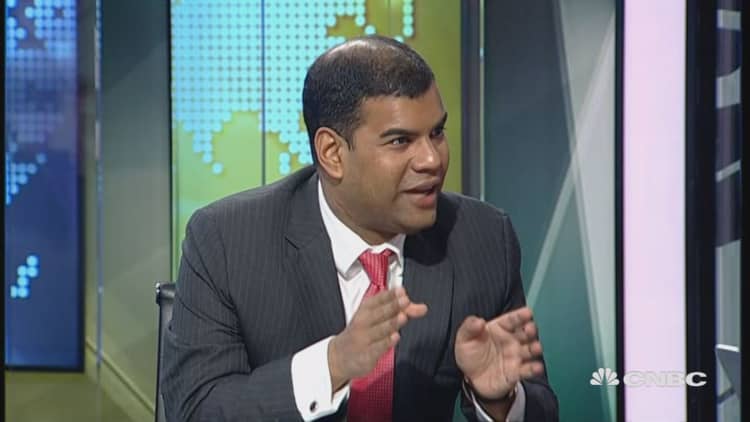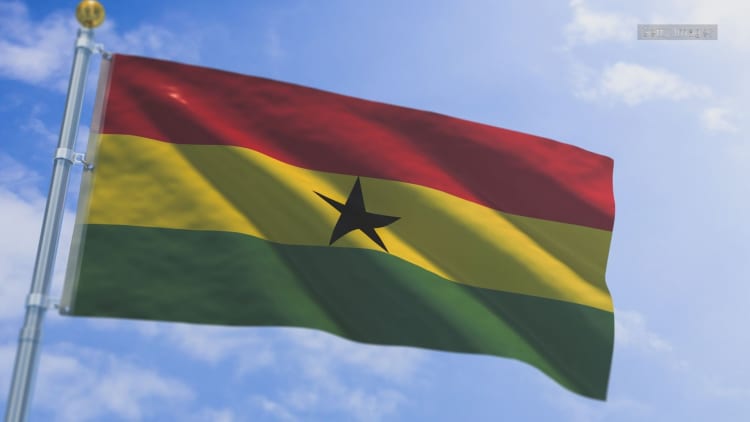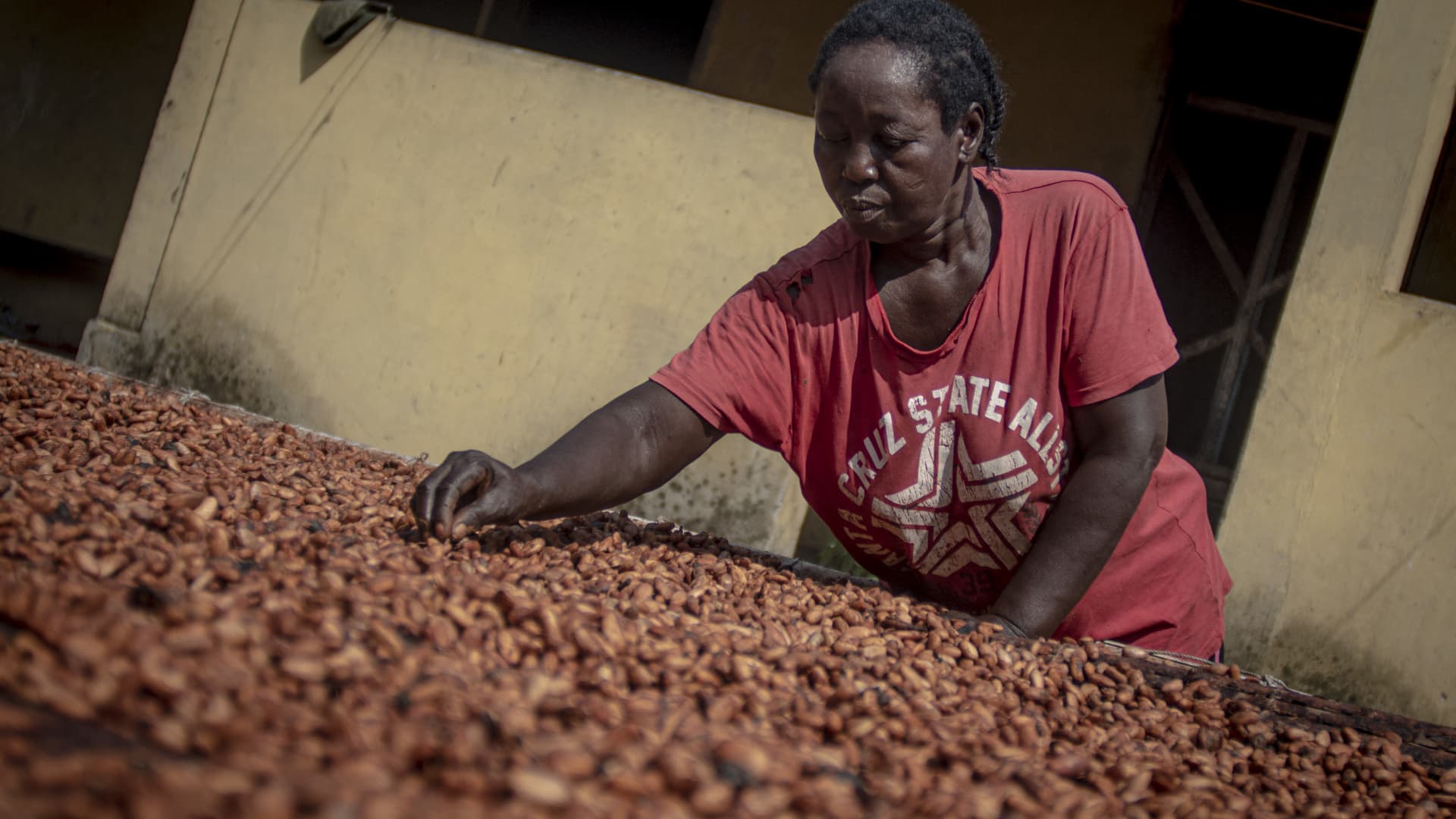A woman spreads cocoa beans during the sun-drying process in the backyard of her house in Asikasu, Ghana on December 19, 2020.
Cristina Aldehuela | Afp | Getty Images
El Nino is here to stay — and that’s bad news for cocoa crops which are highly sensitive to weather changes.
Frequent extreme weather events caused by El Nino and climate change hurts cocoa production. Hotter temperatures and shifts in rainfall patterns can also damage cocoa pod development and promote the spread of pests and diseases.
According to the the latest El Nino-Southern Oscillation Outlook, El Nino is expected to last through January to March 2024, with a 71% chance it will intensify from November to January.
An intensified and frequent El Nino effect could significantly reduce the amount of arable land for cocoa cultivation. This not only poses a threat to food security, but also endangers the livelihoods of farmers, especially those in West African countries, which are most at risk from extreme weather changes.
“El Nino conditions are often historically associated with drier conditions in West Africa where three-quarters of the world’s cocoa is produced,” Jonathan Haines, research director at Gro Intelligence told CNBC.
Top cocoa producers
Cocoa comes from the seed of the cacao tree and is an essential ingredient for chocolates.
But it’s not only used in food and confectionery. Cocoa butter — a byproduct of cocoa processing — is also widely used in the pharmaceutical industry for skincare products and cosmetics.
Cocoa farmers facing critical decisions may start looking to higher-altitude regions where the weather is more favorable for cocoa cultivation…
Kerry Daroci
Rainforest Alliance
Africa accounts for nearly 75% of global cocoa production, while the Americas — including Brazil and Ecuador — make up 20%, according to the International Cocoa Organization. Asia-Pacific produces the remaining 5%, with Indonesia and Papua New Guinea being the largest producers in the region.
West Africa’s Cote d’Ivoire — or the Ivory Coast — is the world’s largest cocoa producer, accounting for about 44% of global production, while neighboring Ghana accounts for about 14%.
Cost of climate change
As temperatures soar, more and more suitable cacao cultivation areas will be pushed uphill by 2050, according to Climate.gov, a climate change science and information portal run by the National Oceanic and Atmospheric Administration.
With the optimal altitude for cacao cultivation expected to rise, cocoa farmers may be forced to move harvests to higher ground.
“Cocoa farmers facing critical decisions may start looking to higher-altitude regions where the weather is more favorable for cocoa cultivation, or some may decide to leave cocoa cultivation altogether,” Kerry Daroci, the cocoa sector lead at the Rainforest Alliance, told CNBC.
The financial damage of climate change can be extremely costly, especially since top cocoa-producers like Ivory Coast, Ghana and Indonesia, are vulnerable to extreme weather conditions.

According to a report by the Economist Intelligence Unit, a high intensity El Nino may result in severe economic disruption across Africa. Businesses in the agricultural sector are also at risk from an increase in farm input prices that can drive up overhead costs.
The financial cost of El Nino and climate change remains unquantified for Cote d’Ivoire and Ghana. However, as profits from cocoa make up 70% to 100% of Ghanaian cocoa producers’ income, any decline in yields will have a substantial impact on their livelihoods, said Daroci from the Rainforest Alliance.
West African producers aren’t the only ones impacted.
“In Indonesia, climate change is reducing productivity by approximately 50%, leading to an estimated loss of $666 per hectare, affecting up to one million hectares,” Daroci added.
We have reached a juncture in the climate crisis where harm reduction is no longer enough.
Kerry Daroci
Rainforest Alliance
As it stands, cocoa prices have already surged to “high premiums,” according to the International Cocoa Organization.
At the end of August, cocoa futures settled at $3,730 per tonne in London, and $3,633 per tonne in New York, ICCO’s latest data showed. That’s a 78% jump from $2,095 per tonne in London a year ago and a nearly 50% year-on-year surge from $2,427 per tonne in New York.
“This represents the highest nearby contract price for the 2022/23 season,” the report said.
Prices of cocoa are at their highest in 50 years, according to a Reuters report.
Adaptation and mitigation
Climate change is not a new phenomenon, but the impact of an intensified El Nino this year has made it more urgent to stem its adverse impact on cocoa production.
“We have reached a juncture in the climate crisis where harm reduction is no longer enough,” said Daroci.
Agricultural adaptation and mitigation efforts are some ways to tackle specific climate threats — but they can be costly.
Climate adaptation refers to adjusting processes and structures to prevent or minimize potential damages caused by climate change. Mitigation involves lessening the impact of climate change by cutting down on emissions of greenhouse gases.
“Research indicates that investments in these initiatives must triple by 2030 and quadruple by 2050,” Daroci said. “This would result in a total investment of up to $8.1 trillion over time, with an annual investment rate of $536 billion in the future.”
“Despite the urgent need to invest in nature-based solutions, a significant funding gap remains,” she added.
Separately, a report by the Environmental Protection Agency — an independent agency of the U.S. government responsible for environmental protection matters — underscored financing as a key challenge to investing in adaptation in Ghana.
“The understanding of climate change in main cocoa producing countries like West Africa and Indonesia, is very rudimentary,” Steffany Bermudez, policy advisor at the International Institute for Sustainable Development, told CNBC.
Helping cocoa farmers
Additionally, adaptation methods often do not have immediate returns, and that deters financial institutions from investing in these areas.
“Private sector capital can be instrumental in the adoption of actions to adapt to climate change,” Bermudez said, adding that support from the private sector can be “a bridge for engagement with key financiers to build the sector’s resilience.”
Projects and initiatives organized by non-profit organizations can also help alleviate the financial burden on cocoa farmers learning to adapt to climate change.

The Rainforest Alliance, a non-governmental organization, started the Restore project — or Resilient Ecosystems and Transforming Rural Cocoa Economies, in Cote d’Ivoire and Ghana.
The project has set aside $7 million to help 15,000 farmers manage 50,000 hectares of farmland, and aims to expand tree cover in cocoa production landscapes across the two countries.
Even though the challenges for cocoa farmers are mounting, there could be some reprieve.
Cocoa cultivation may fare better than expected this year, as higher levels of rain ease the impact of elevated droughts from El Nino, Haines from Gro Intelligence said.
“Precipitation in Cote d’Ivoire and Ghana has actually been very strong in 2023 … In Ghana, rainfall in cocoa areas is at its highest level since at least 2001 by a strong margin,” Haines told CNBC.
— CNBC’s Joanna Tan contributed to this report.

